Home / Basicity of Amines And pKaH
Amines
Basicity of Amines And pKaH
Last updated: June 12th, 2025 |
Quantifying The Basicity Of Amines, Using “The pKa Of The Conjugate Acid”, a.k.a. “pKaH”
How do you measure the basicity of an amine? Case in point: what’s a stronger base: pyridine or piperidine?
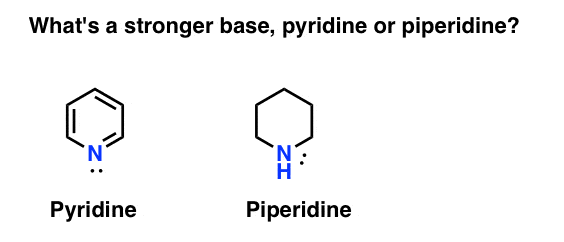
If you said piperidine, congratulations – it is indeed a stronger base.
But why? And how much stronger? How does one go about trying to answer these questions? After all, we can easily compare the strength of acids by examining their pKa‘s. Shouldn’t we be able to do the same with bases?
Yes, in a way. Here’s three key points for today:
- The best way to quantify the basicity of an amine is to examine the pKa of its conjugate acid.
- The higher the pKa of the conjugate acid, the stronger the base.
- An unofficial but useful shorthand for “the pKa of the conjugate acid” is the term, pKaH
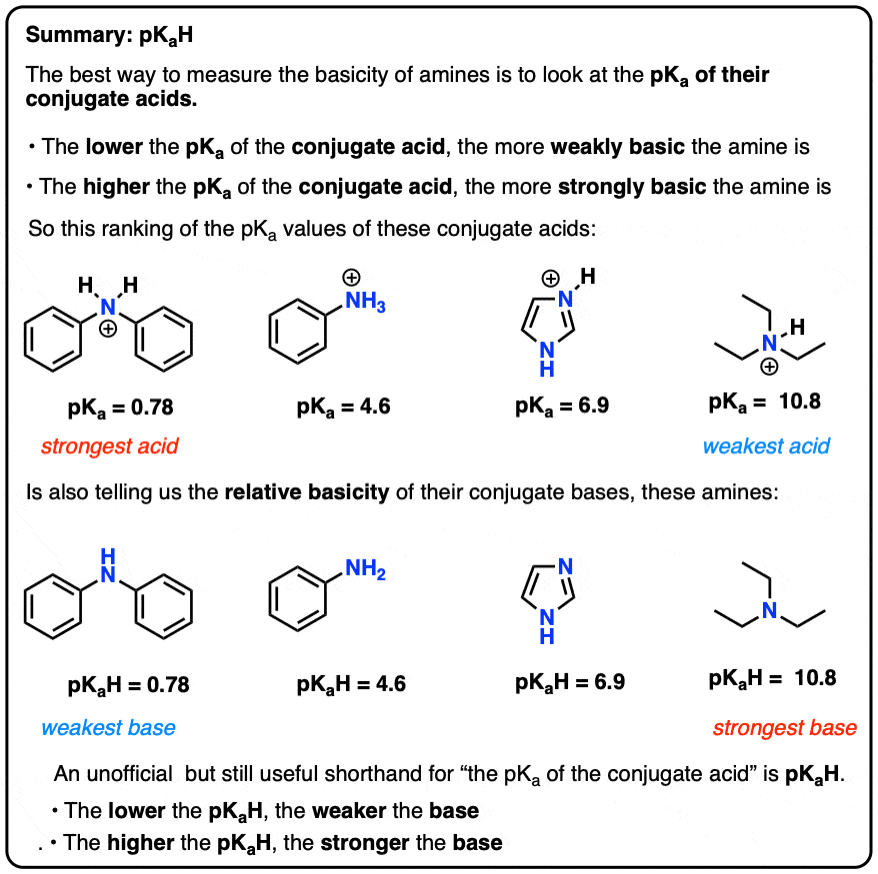
Table of Contents
- Quick Review: Acids, Bases, Conjugate Acids, and Conjugate Bases
- Using pKa To Measure Acidity
- Using pKa To Quantify The Basicity Of Amines
- The “pKa Of The Conjugate Acid” Can Be Abbreviated As “pKaH”
- Using pKaH To Determine The Relative Basicities Of Amines
- Some Words Of Caution On pKa Values For Amines
- What Key Factors Govern The Basicity Of Amines?
- Notes
- Quiz Yourself!
1. Quick Review: Acids, Bases, Conjugate Acids, and Conjugate Bases
First, let’s quickly review some basicity basics.
There are four actors in every acid-base reaction.
- The base is the species which donates a lone pair to H+ (also known as a “proton” or “hydrogen nucleus”). It’s where the new bond to H forms (e.g. pyridine, below)
- The conjugate acid is the species that results after the base forms a bond to H (e.g. “pyridinium” , which has a new N–H bond)
- The acid is the species which loses H+ . It’s where the bond to H breaks (e.g. H–Cl)
- The conjugate base is the species that remains after the acid donates H+ to the base (e.g. Cl-)
Here’s pyridine and piperidine in action. By following the bonds that form and break, you can identify each actor.
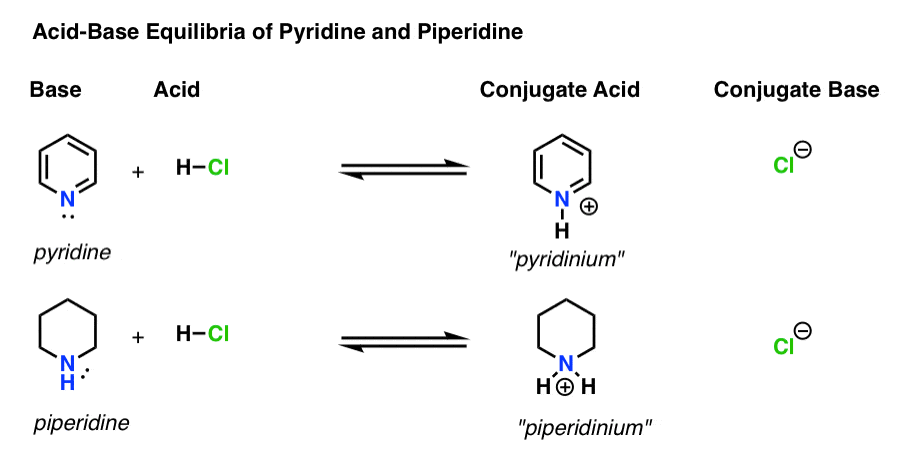
2. Using pKa To Measure Acidity
Every acid-base reaction can be written as an equilibrium between a forward and reverse reaction. We’ve seen that the acidity constant, Ka, is a measure of how easily a species dissociates to give H+ and the conjugate base.
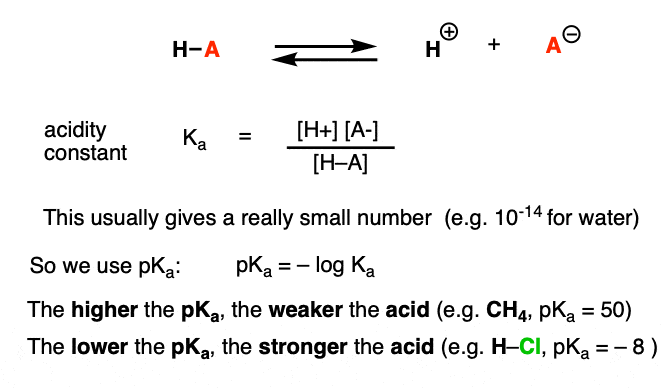
For convenience, we use the negative log of Ka, called pKa, which is similar to the familiar pH scale but can extend beyond 14 because it’s not strictly limited to aqueous solvent. pKa values range from –10 or so for very strong acids (e.g. hydroiodic acid, H–I) to 50 and above for certain hydrocarbons (e.g. ethane).
How can we apply these cncepts to measure basicity? Couldn’t we switch things around and define a term, Kb, which is the equilibrium for how readily a species combines with H+ , define pKb as its negative log, and compare bases by looking at their pKb values?

Yes…. we could. I guess. If we had to. But generally, organic chemists’ opinion on this subject is “Screw pKb“.
After all, pKa values have been measured for thousands of organic molecules. Does anyone really want to have to remember a huge set of pKb values too? Hell no!
Instead, we can easily use pKa values as an indirect measurement of basicity. Here’s how.
3. Using pKa Values To Quantify Basicity of Amines
Recall these two immortal lines of prose, worth reciting to yourself nightly:
- The stronger the acid, the weaker the conjugate base.
- The weaker the acid, the stronger the conjugate base.
[Don’t leave out the word “conjugate” ! Note 1]
The pKa for the conjugate acid of pyridine (“pyridinium”) has been measured. It’s about 5.2 . [Source – also see Footnote 2]
We also have a value for the pKa for the conjugate acid of piperidine. It’s about 11 .
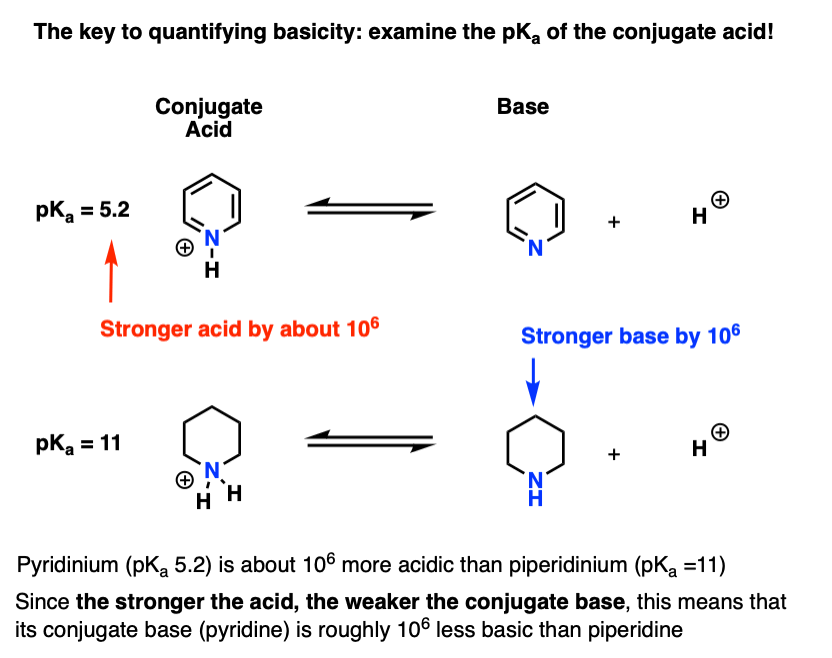
From these pKa values, we can tell that the conjugate acid of pyridine is stronger than the conjugate acid of piperidine by about 6 pKa units. Since each pKa unit represents a factor of 10, that’s a factor of about 1 million.
Since “the stronger the acid, the weaker the conjugate base”, pyridine is therefore a weaker base than piperidine by a factor of 1 million.
4. “The pKa Of The Conjugate Acid” Can Be Abbreviated as “pKaH”
The term, “pKa of the conjugate acid” is a bit of a mouthful to use on a regular basis. Being naturally lazy, we’d like to condense this a bit for common usage.
Since the conjugate acid of a base (“B”) is “BH”, we can abbreviate “the pKa of the conjugate acid of a base” as its pKaH.
This lets us say that the pKaH of pyridine is 5.2, and the pKaH of piperidine is 11.
We can then dig into the literature to find other bases to compare it to.
For instance, exactly how basic is ammonia (NH3) ? The conjugate acid of ammonia, NH4(+), is 9.2 . Equivalently, we can say that the pKaH of ammonia is 9.2. This puts it in-between pyridine and piperidine on the basicity scale.
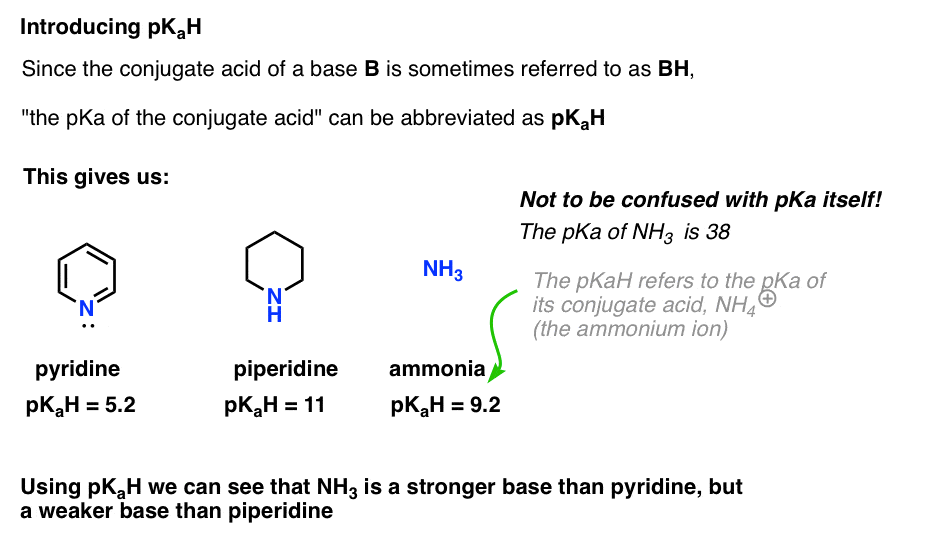
Note that it’s very important not to confuse pKaH with pKa. The pKaH of ammonia is 9.2, which measures the acidity of its conjugate acid, NH4(+).
The pKa of ammonia itself is 38, which measures the equilibrium constant for dissociation of NH3 to give its conjugate base, NH2(-) and H+.
That means that 38 is the pKaH of the amide ion NH2(–), which you may have encountered before as the strong base (NaNH2) used to deprotonate terminal alkynes (pKa =25). Using pKaH, we can determine that NH2(–) is about (38 – 9) = 29 orders of magnitude more basic than NH3 !
5. Using pKaH to Determine The Relative Basicities Of Amines
Using pKaH to determine the relative strengths of bases is a pretty useful trick.
Here are some representative examples of nitrogen-containing molecules. Below is the pKa of their conjugate acids.
What’s the strongest base here? What’s the weakest?
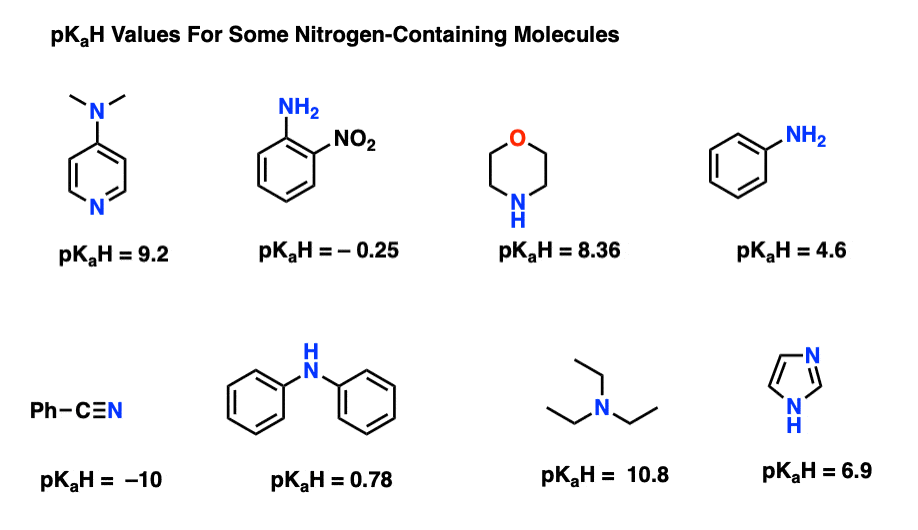
The lowest pKaH value here is –10 for the nitrile (bottom left). This means the nitrile is the least basic of all of these molecules.
The highest pKaH value here is 10.8 for triethylamine. That makes triethylamine the strongest base out of all of those listed.
6. Some Words Of Caution On pKa Values For Amines
Two things to watch out for, especially when reading other online sources on this topic.
First, sometimes the pKaH values for amines are reported as pKa values , without explanation. The best pKa tables won’t do this, but it’s hard to sort the wheat from the chaff when you are just starting out.
If you see an anomalously low pKa value for an amine, it’s likely referring to the pKaH , the pKa of the conjugate acid.
For instance, you might see a pKa table where the pKa of methylamine (CH3NH2) is listed as 10.63.
That’s low. Hopefully by this point, such a value of 10 for a pKa of an amine should strike you as weird, especially since the pKa of the closely related NH3 is 38.
The value of 10.63 actually refers to the pKa of the conjugate acid of methyl amine, NOT methylamine itself. It’s a pKaH value.
Similarly, the same table lists trimethylamine as having a pKa of 9.8 . Again, this is actually its pKaH. I can’t find an actual pKa value for trimethylamine, but I would guess that it is >40, since the conjugate base of trimethylamine is the carbanion (CH3)2N–CH2(–) ).
A second, less common source of confusion is that sometimes the pKaH of an amine is reported as its pKb, such as in this table which reports the pKb of NH3 as 9.2 . This is inaccurate.
[The pKb of NH3 can be calculated from the formula pKaH + pKb = 14 . The pKb of NH3 is 4.8 (aqueous solution). ]
Again, pKb values don’t really come up much in undergraduate organic chemistry, although I’m told that they sometimes make an appearance on the DAT/MCAT.
7. What Key Factors Govern The Basicity Of Amines?
Now that we’ve learned at least how to quantify and interpret the pKa values of amines and their conjugate acids, we can start to ask the key question: why? What key factors govern the basicity of amines? What are the important trends?
For instance, why is pyridine a weaker base than piperidine? Why are nitriles even weaker bases? Why do electron withdrawing groups tend to make amines weaker bases?
The good news is that if you already understand the factors that govern acidity, you simply have to apply the exact same principles – but in reverse!
We’ll cover that in the next post. Five Factors That Affect The Basicity of Amines
Notes
Related Articles
Note 1. There are many acids which are non-bases (such as NH4 which lacks a lone pair) and many bases which are non-acids, such as Cl(–), which is incapable of accepting a lone pair. Hence, saying “the stronger the acid, the weaker the base” is wrong.
Note 2. That’s the measurement obtained using water as solvent. You might see another value, 3.4, which is obtained when dimethylsulfoxide (DMSO) is used as a solvent. See Bordwell pKa Tables (DMSO)
Note 3. Melting point, boiling point, density and water solubility data for the first ten aliphatic linear amines.

Quiz Yourself!
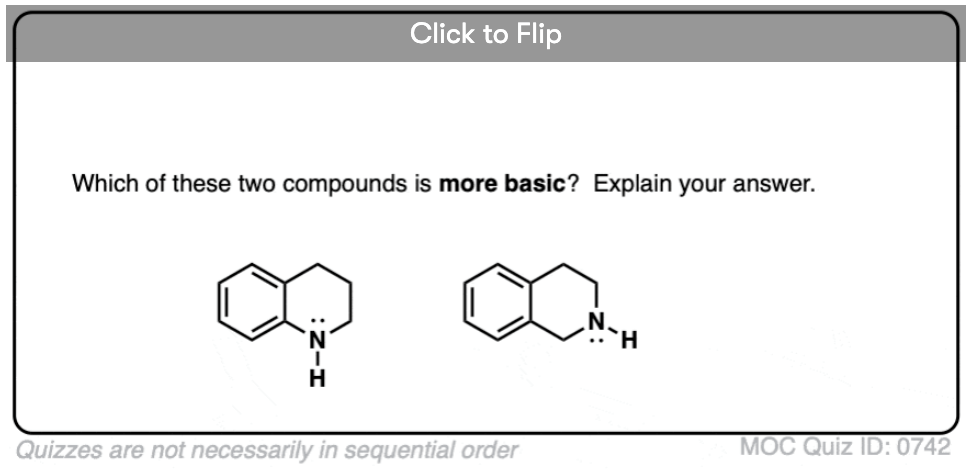
Become a MOC member to see the clickable quiz with answers on the back.
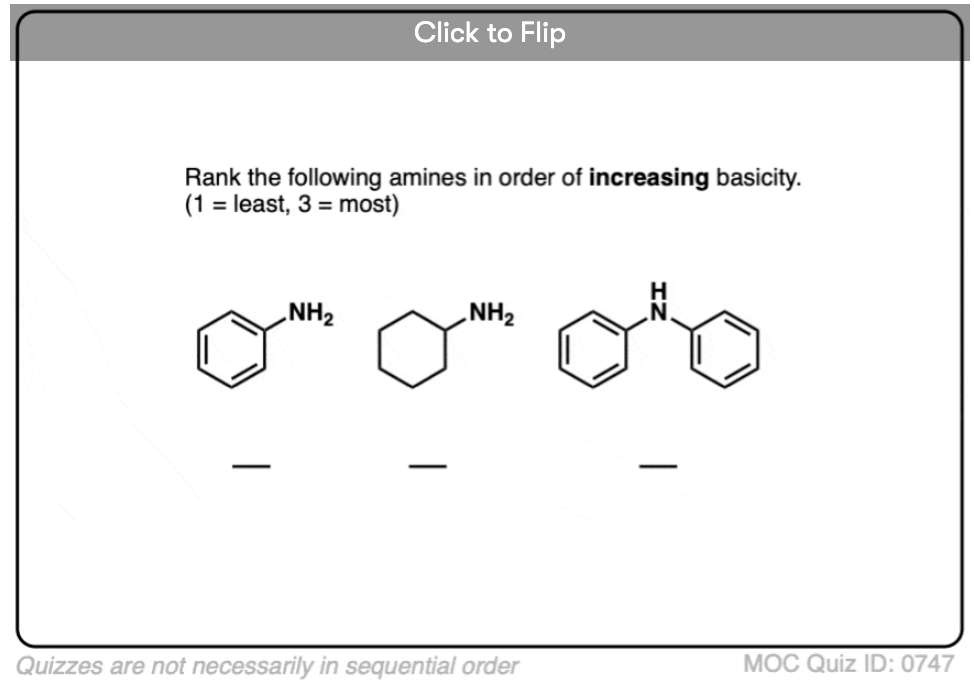
Become a MOC member to see the clickable quiz with answers on the back.
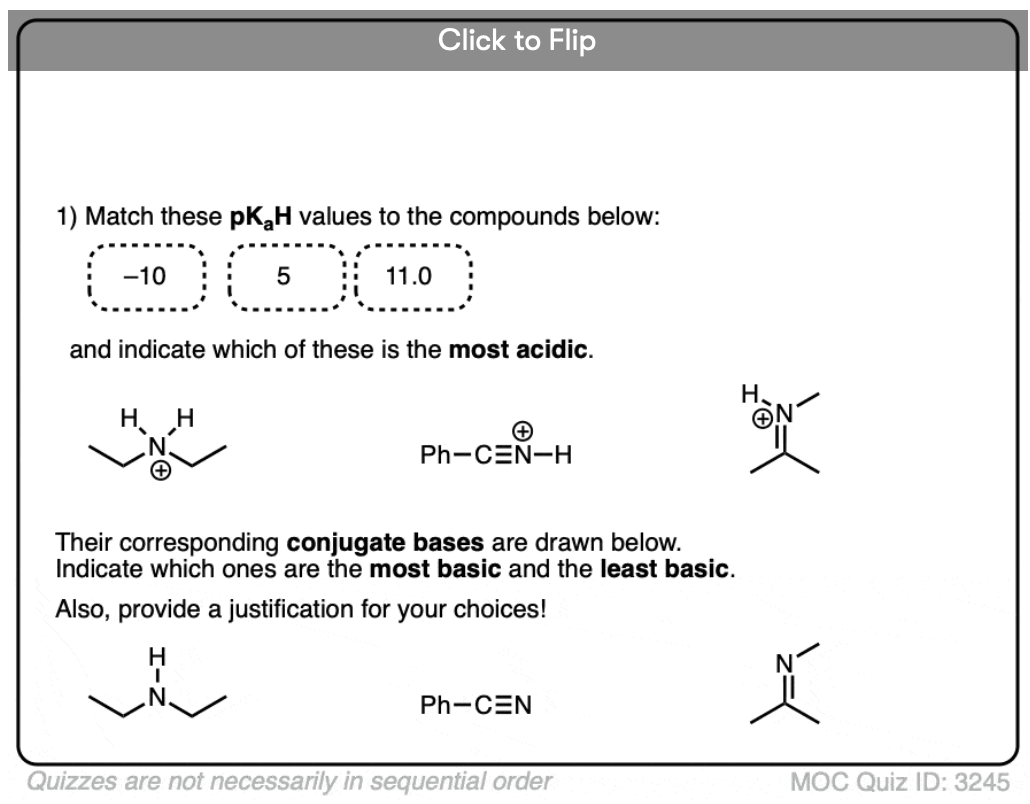
Become a MOC member to see the clickable quiz with answers on the back.
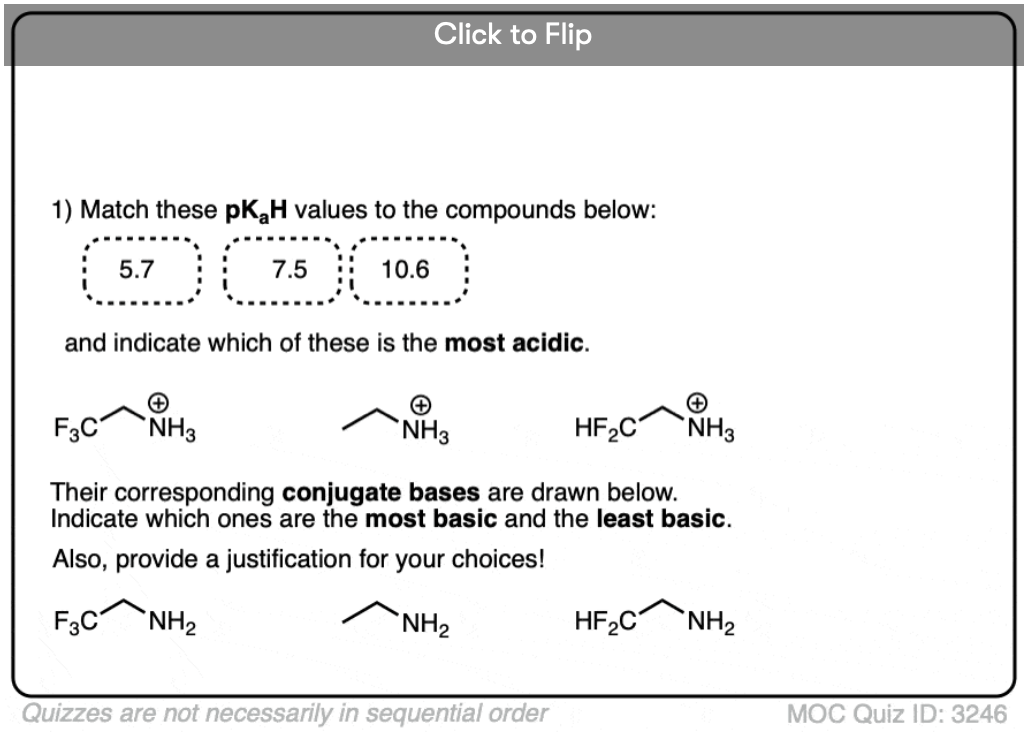
Become a MOC member to see the clickable quiz with answers on the back.
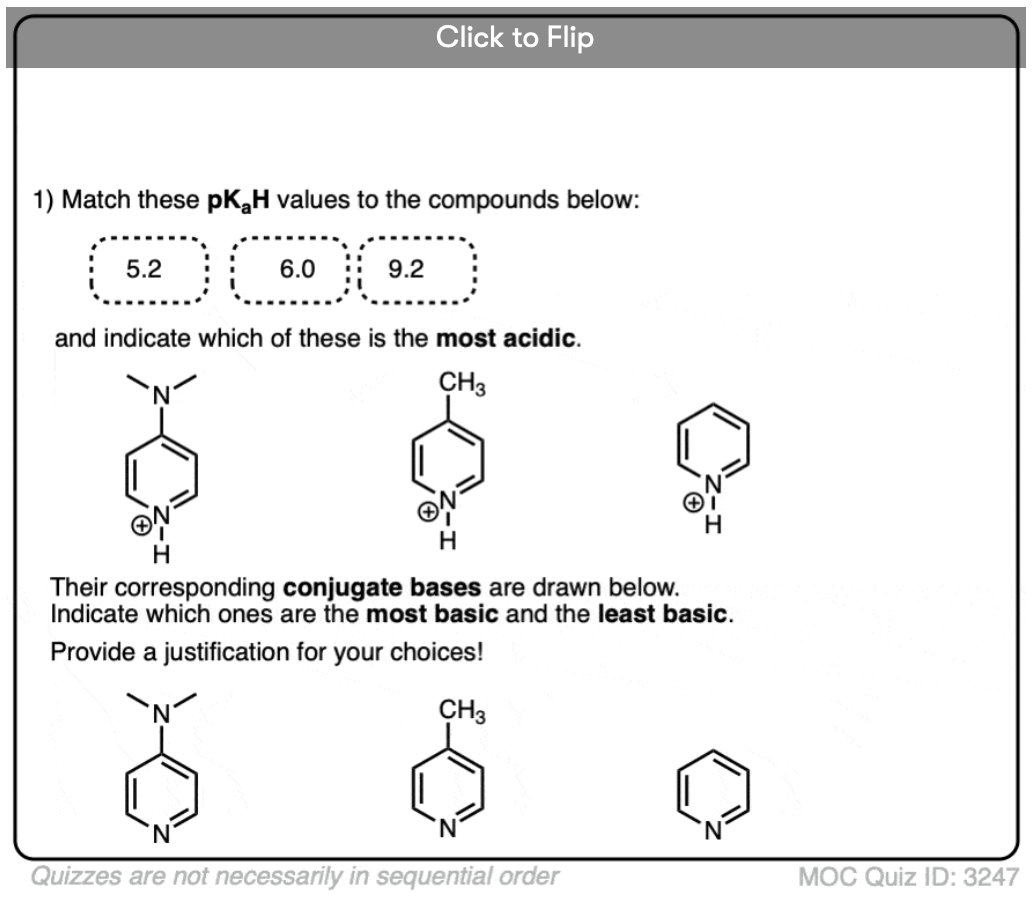
Become a MOC member to see the clickable quiz with answers on the back.
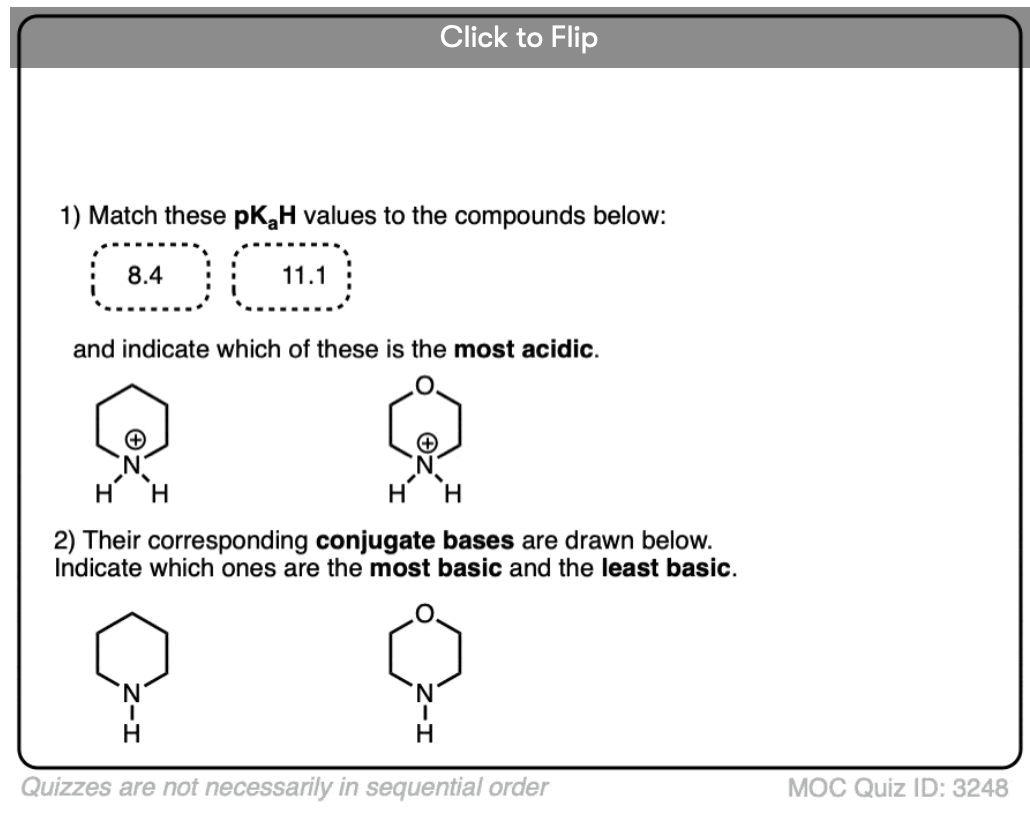
Become a MOC member to see the clickable quiz with answers on the back.
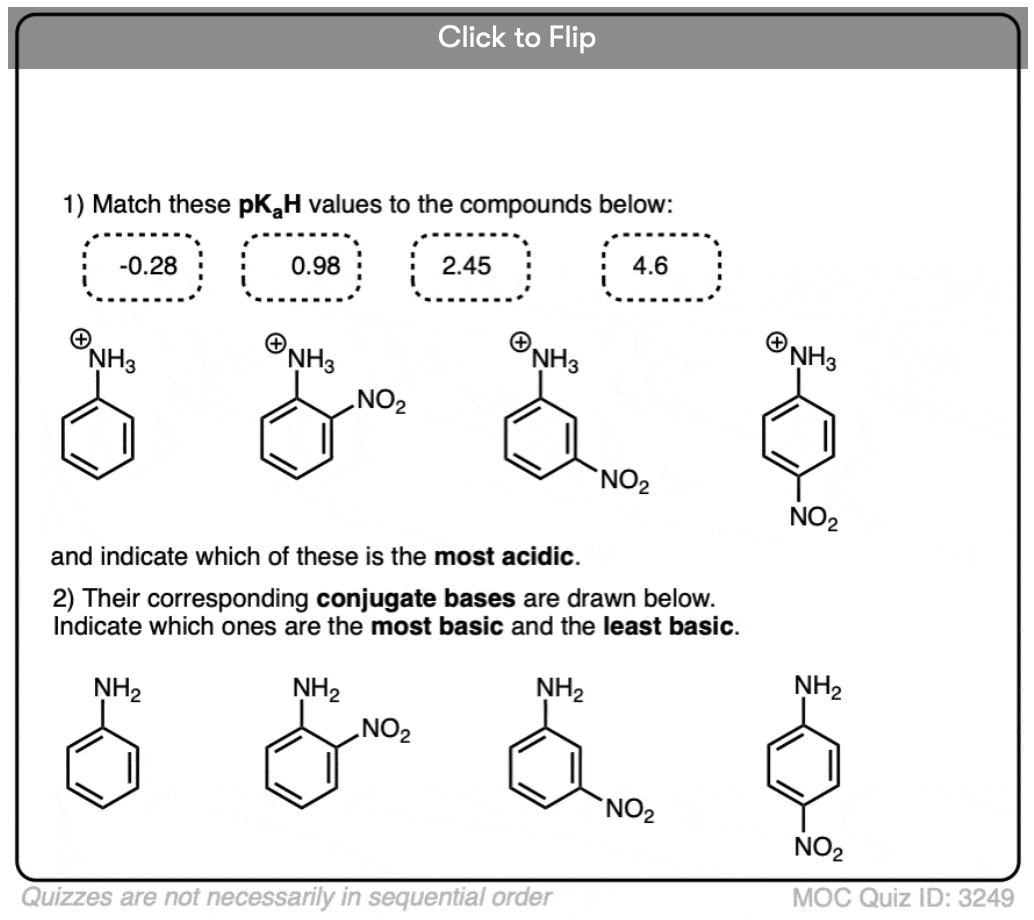
Become a MOC member to see the clickable quiz with answers on the back.
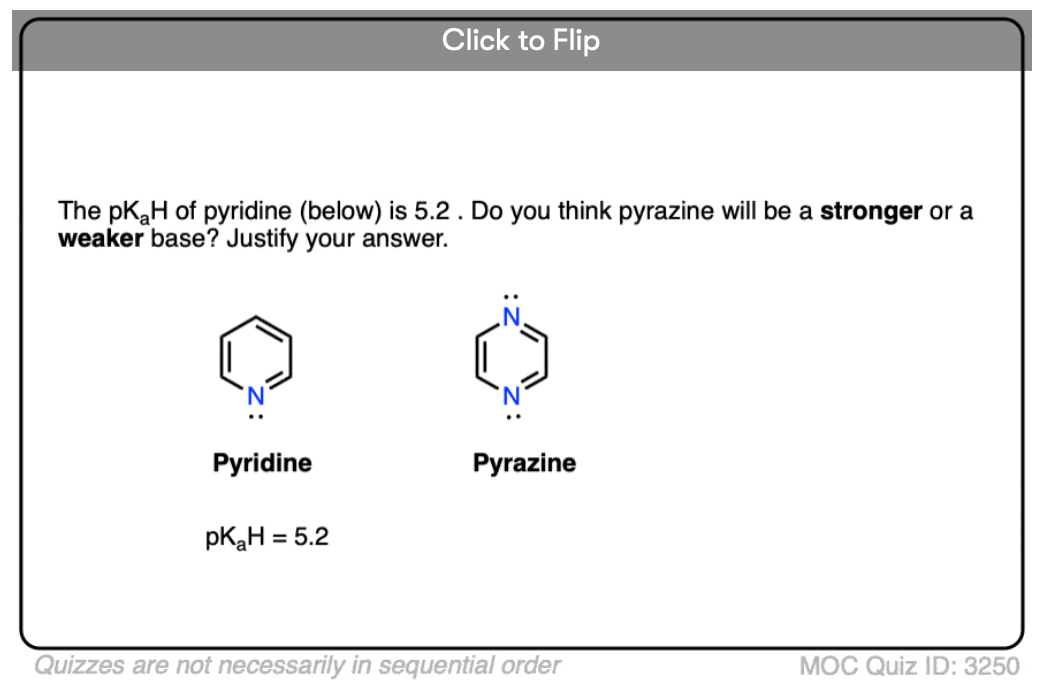
Become a MOC member to see the clickable quiz with answers on the back.
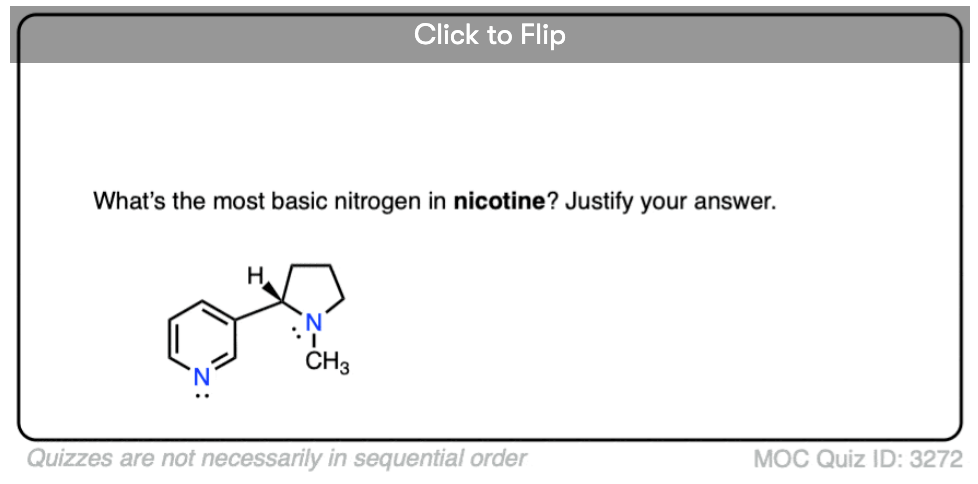
Become a MOC member to see the clickable quiz with answers on the back.
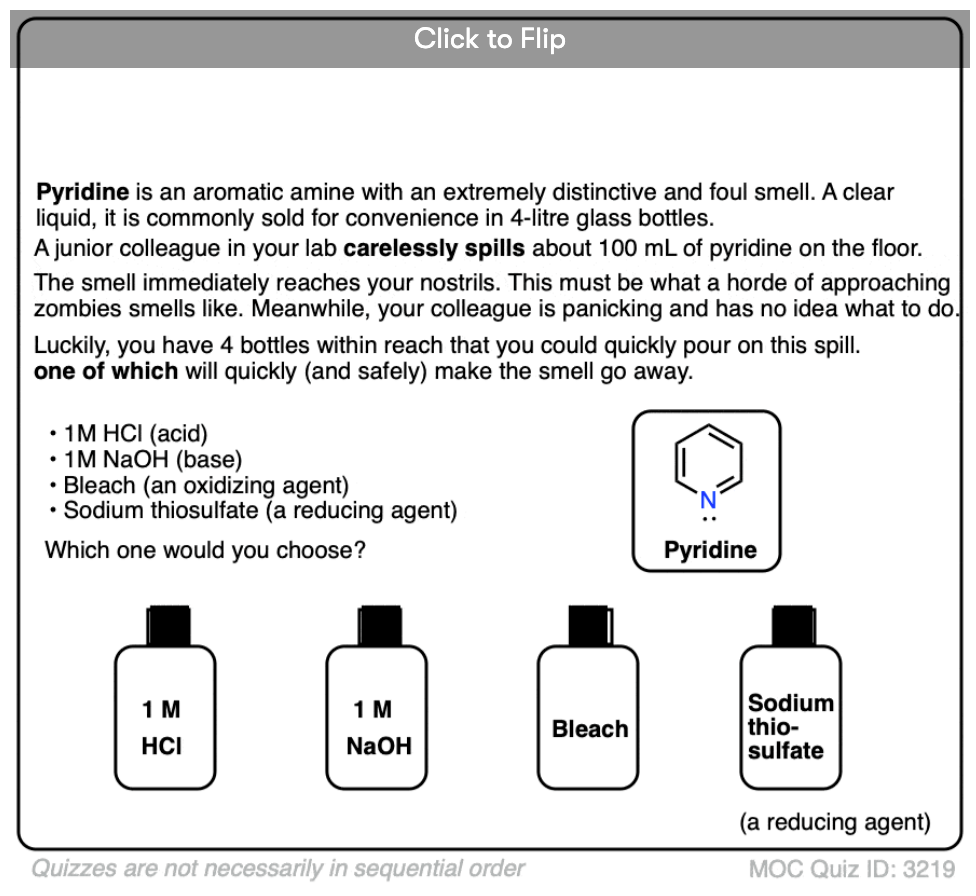
Become a MOC member to see the clickable quiz with answers on the back.
00 General Chemistry Review
01 Bonding, Structure, and Resonance
- How Do We Know Methane (CH4) Is Tetrahedral?
- Hybrid Orbitals and Hybridization
- How To Determine Hybridization: A Shortcut
- Orbital Hybridization And Bond Strengths
- Sigma bonds come in six varieties: Pi bonds come in one
- A Key Skill: How to Calculate Formal Charge
- The Four Intermolecular Forces and How They Affect Boiling Points
- 3 Trends That Affect Boiling Points
- How To Use Electronegativity To Determine Electron Density (and why NOT to trust formal charge)
- Introduction to Resonance
- How To Use Curved Arrows To Interchange Resonance Forms
- Evaluating Resonance Forms (1) - The Rule of Least Charges
- How To Find The Best Resonance Structure By Applying Electronegativity
- Evaluating Resonance Structures With Negative Charges
- Evaluating Resonance Structures With Positive Charge
- Exploring Resonance: Pi-Donation
- Exploring Resonance: Pi-acceptors
- In Summary: Evaluating Resonance Structures
- Drawing Resonance Structures: 3 Common Mistakes To Avoid
- How to apply electronegativity and resonance to understand reactivity
- Bond Hybridization Practice
- Structure and Bonding Practice Quizzes
- Resonance Structures Practice
02 Acid Base Reactions
- Introduction to Acid-Base Reactions
- Acid Base Reactions In Organic Chemistry
- The Stronger The Acid, The Weaker The Conjugate Base
- Walkthrough of Acid-Base Reactions (3) - Acidity Trends
- Five Key Factors That Influence Acidity
- Acid-Base Reactions: Introducing Ka and pKa
- How to Use a pKa Table
- The pKa Table Is Your Friend
- A Handy Rule of Thumb for Acid-Base Reactions
- Acid Base Reactions Are Fast
- pKa Values Span 60 Orders Of Magnitude
- How Protonation and Deprotonation Affect Reactivity
- Acid Base Practice Problems
03 Alkanes and Nomenclature
- Meet the (Most Important) Functional Groups
- Condensed Formulas: Deciphering What the Brackets Mean
- Hidden Hydrogens, Hidden Lone Pairs, Hidden Counterions
- Don't Be Futyl, Learn The Butyls
- Primary, Secondary, Tertiary, Quaternary In Organic Chemistry
- Branching, and Its Affect On Melting and Boiling Points
- The Many, Many Ways of Drawing Butane
- Wedge And Dash Convention For Tetrahedral Carbon
- Common Mistakes in Organic Chemistry: Pentavalent Carbon
- Table of Functional Group Priorities for Nomenclature
- Summary Sheet - Alkane Nomenclature
- Organic Chemistry IUPAC Nomenclature Demystified With A Simple Puzzle Piece Approach
- Boiling Point Quizzes
- Organic Chemistry Nomenclature Quizzes
04 Conformations and Cycloalkanes
- Staggered vs Eclipsed Conformations of Ethane
- Conformational Isomers of Propane
- Newman Projection of Butane (and Gauche Conformation)
- Introduction to Cycloalkanes
- Geometric Isomers In Small Rings: Cis And Trans Cycloalkanes
- Calculation of Ring Strain In Cycloalkanes
- Cycloalkanes - Ring Strain In Cyclopropane And Cyclobutane
- Cyclohexane Conformations
- Cyclohexane Chair Conformation: An Aerial Tour
- How To Draw The Cyclohexane Chair Conformation
- The Cyclohexane Chair Flip
- The Cyclohexane Chair Flip - Energy Diagram
- Substituted Cyclohexanes - Axial vs Equatorial
- Ranking The Bulkiness Of Substituents On Cyclohexanes: "A-Values"
- Cyclohexane Chair Conformation Stability: Which One Is Lower Energy?
- Fused Rings - Cis-Decalin and Trans-Decalin
- Naming Bicyclic Compounds - Fused, Bridged, and Spiro
- Bredt's Rule (And Summary of Cycloalkanes)
- Newman Projection Practice
- Cycloalkanes Practice Problems
05 A Primer On Organic Reactions
- The Most Important Question To Ask When Learning a New Reaction
- Curved Arrows (for reactions)
- Nucleophiles and Electrophiles
- The Three Classes of Nucleophiles
- Nucleophilicity vs. Basicity
- What Makes A Good Nucleophile?
- What Makes A Good Leaving Group?
- 3 Factors That Stabilize Carbocations
- Equilibrium and Energy Relationships
- 7 Factors that stabilize negative charge in organic chemistry
- 7 Factors That Stabilize Positive Charge in Organic Chemistry
- What's a Transition State?
- Hammond's Postulate
- Learning Organic Chemistry Reactions: A Checklist (PDF)
- Introduction to Oxidative Cleavage Reactions
06 Free Radical Reactions
- Free Radical Reactions
- 3 Factors That Stabilize Free Radicals
- Bond Strengths And Radical Stability
- Free Radical Initiation: Why Is "Light" Or "Heat" Required?
- Initiation, Propagation, Termination
- Monochlorination Products Of Propane, Pentane, And Other Alkanes
- Selectivity In Free Radical Reactions
- Selectivity in Free Radical Reactions: Bromination vs. Chlorination
- Halogenation At Tiffany's
- Allylic Bromination
- Bonus Topic: Allylic Rearrangements
- In Summary: Free Radicals
- Synthesis (2) - Reactions of Alkanes
- Free Radicals Practice Quizzes
07 Stereochemistry and Chirality
- Types of Isomers: Constitutional Isomers, Stereoisomers, Enantiomers, and Diastereomers
- How To Draw The Enantiomer Of A Chiral Molecule
- How To Draw A Bond Rotation
- Introduction to Assigning (R) and (S): The Cahn-Ingold-Prelog Rules
- Assigning Cahn-Ingold-Prelog (CIP) Priorities (2) - The Method of Dots
- Enantiomers vs Diastereomers vs The Same? Two Methods For Solving Problems
- Assigning R/S To Newman Projections (And Converting Newman To Line Diagrams)
- How To Determine R and S Configurations On A Fischer Projection
- The Meso Trap
- Optical Rotation, Optical Activity, and Specific Rotation
- Optical Purity and Enantiomeric Excess
- What's a Racemic Mixture?
- Chiral Allenes And Chiral Axes
- Stereochemistry Practice Problems and Quizzes
08 Substitution Reactions
- Nucleophilic Substitution Reactions - Introduction
- Two Types of Nucleophilic Substitution Reactions
- The SN2 Mechanism
- Why the SN2 Reaction Is Powerful
- The SN1 Mechanism
- The Conjugate Acid Is A Better Leaving Group
- Comparing the SN1 and SN2 Reactions
- Polar Protic? Polar Aprotic? Nonpolar? All About Solvents
- Steric Hindrance is Like a Fat Goalie
- Common Blind Spot: Intramolecular Reactions
- Substitution Practice - SN1
- Substitution Practice - SN2
09 Elimination Reactions
- Elimination Reactions (1): Introduction And The Key Pattern
- Elimination Reactions (2): The Zaitsev Rule
- Elimination Reactions Are Favored By Heat
- Two Elimination Reaction Patterns
- The E1 Reaction
- The E2 Mechanism
- E1 vs E2: Comparing the E1 and E2 Reactions
- Antiperiplanar Relationships: The E2 Reaction and Cyclohexane Rings
- Bulky Bases in Elimination Reactions
- Comparing the E1 vs SN1 Reactions
- Elimination (E1) Reactions With Rearrangements
- E1cB - Elimination (Unimolecular) Conjugate Base
- Elimination (E1) Practice Problems And Solutions
- Elimination (E2) Practice Problems and Solutions
10 Rearrangements
11 SN1/SN2/E1/E2 Decision
- Identifying Where Substitution and Elimination Reactions Happen
- Deciding SN1/SN2/E1/E2 (1) - The Substrate
- Deciding SN1/SN2/E1/E2 (2) - The Nucleophile/Base
- SN1 vs E1 and SN2 vs E2 : The Temperature
- Deciding SN1/SN2/E1/E2 - The Solvent
- Wrapup: The Key Factors For Determining SN1/SN2/E1/E2
- Alkyl Halide Reaction Map And Summary
- SN1 SN2 E1 E2 Practice Problems
12 Alkene Reactions
- E and Z Notation For Alkenes (+ Cis/Trans)
- Alkene Stability
- Alkene Addition Reactions: "Regioselectivity" and "Stereoselectivity" (Syn/Anti)
- Stereoselective and Stereospecific Reactions
- Hydrohalogenation of Alkenes and Markovnikov's Rule
- Hydration of Alkenes With Aqueous Acid
- Rearrangements in Alkene Addition Reactions
- Halogenation of Alkenes and Halohydrin Formation
- Oxymercuration Demercuration of Alkenes
- Hydroboration Oxidation of Alkenes
- m-CPBA (meta-chloroperoxybenzoic acid)
- OsO4 (Osmium Tetroxide) for Dihydroxylation of Alkenes
- Palladium on Carbon (Pd/C) for Catalytic Hydrogenation of Alkenes
- Cyclopropanation of Alkenes
- A Fourth Alkene Addition Pattern - Free Radical Addition
- Alkene Reactions: Ozonolysis
- Summary: Three Key Families Of Alkene Reaction Mechanisms
- Synthesis (4) - Alkene Reaction Map, Including Alkyl Halide Reactions
- Alkene Reactions Practice Problems
13 Alkyne Reactions
- Acetylides from Alkynes, And Substitution Reactions of Acetylides
- Partial Reduction of Alkynes With Lindlar's Catalyst
- Partial Reduction of Alkynes With Na/NH3 To Obtain Trans Alkenes
- Alkyne Hydroboration With "R2BH"
- Hydration and Oxymercuration of Alkynes
- Hydrohalogenation of Alkynes
- Alkyne Halogenation: Bromination and Chlorination of Alkynes
- Oxidation of Alkynes With O3 and KMnO4
- Alkenes To Alkynes Via Halogenation And Elimination Reactions
- Alkynes Are A Blank Canvas
- Synthesis (5) - Reactions of Alkynes
- Alkyne Reactions Practice Problems With Answers
14 Alcohols, Epoxides and Ethers
- Alcohols - Nomenclature and Properties
- Alcohols Can Act As Acids Or Bases (And Why It Matters)
- Alcohols - Acidity and Basicity
- The Williamson Ether Synthesis
- Ethers From Alkenes, Tertiary Alkyl Halides and Alkoxymercuration
- Alcohols To Ethers via Acid Catalysis
- Cleavage Of Ethers With Acid
- Epoxides - The Outlier Of The Ether Family
- Opening of Epoxides With Acid
- Epoxide Ring Opening With Base
- Making Alkyl Halides From Alcohols
- Tosylates And Mesylates
- PBr3 and SOCl2
- Elimination Reactions of Alcohols
- Elimination of Alcohols To Alkenes With POCl3
- Alcohol Oxidation: "Strong" and "Weak" Oxidants
- Demystifying The Mechanisms of Alcohol Oxidations
- Protecting Groups For Alcohols
- Thiols And Thioethers
- Calculating the oxidation state of a carbon
- Oxidation and Reduction in Organic Chemistry
- Oxidation Ladders
- SOCl2 Mechanism For Alcohols To Alkyl Halides: SN2 versus SNi
- Alcohol Reactions Roadmap (PDF)
- Alcohol Reaction Practice Problems
- Epoxide Reaction Quizzes
- Oxidation and Reduction Practice Quizzes
15 Organometallics
- What's An Organometallic?
- Formation of Grignard and Organolithium Reagents
- Organometallics Are Strong Bases
- Reactions of Grignard Reagents
- Protecting Groups In Grignard Reactions
- Synthesis Problems Involving Grignard Reagents
- Grignard Reactions And Synthesis (2)
- Organocuprates (Gilman Reagents): How They're Made
- Gilman Reagents (Organocuprates): What They're Used For
- The Heck, Suzuki, and Olefin Metathesis Reactions (And Why They Don't Belong In Most Introductory Organic Chemistry Courses)
- Reaction Map: Reactions of Organometallics
- Grignard Practice Problems
16 Spectroscopy
- Degrees of Unsaturation (or IHD, Index of Hydrogen Deficiency)
- Conjugation And Color (+ How Bleach Works)
- Introduction To UV-Vis Spectroscopy
- UV-Vis Spectroscopy: Absorbance of Carbonyls
- UV-Vis Spectroscopy: Practice Questions
- Bond Vibrations, Infrared Spectroscopy, and the "Ball and Spring" Model
- Infrared Spectroscopy: A Quick Primer On Interpreting Spectra
- IR Spectroscopy: 4 Practice Problems
- 1H NMR: How Many Signals?
- Homotopic, Enantiotopic, Diastereotopic
- Diastereotopic Protons in 1H NMR Spectroscopy: Examples
- 13-C NMR - How Many Signals
- Liquid Gold: Pheromones In Doe Urine
- Natural Product Isolation (1) - Extraction
- Natural Product Isolation (2) - Purification Techniques, An Overview
- Structure Determination Case Study: Deer Tarsal Gland Pheromone
17 Dienes and MO Theory
- What To Expect In Organic Chemistry 2
- Are these molecules conjugated?
- Conjugation And Resonance In Organic Chemistry
- Bonding And Antibonding Pi Orbitals
- Molecular Orbitals of The Allyl Cation, Allyl Radical, and Allyl Anion
- Pi Molecular Orbitals of Butadiene
- Reactions of Dienes: 1,2 and 1,4 Addition
- Thermodynamic and Kinetic Products
- More On 1,2 and 1,4 Additions To Dienes
- s-cis and s-trans
- The Diels-Alder Reaction
- Cyclic Dienes and Dienophiles in the Diels-Alder Reaction
- Stereochemistry of the Diels-Alder Reaction
- Exo vs Endo Products In The Diels Alder: How To Tell Them Apart
- HOMO and LUMO In the Diels Alder Reaction
- Why Are Endo vs Exo Products Favored in the Diels-Alder Reaction?
- Diels-Alder Reaction: Kinetic and Thermodynamic Control
- The Retro Diels-Alder Reaction
- The Intramolecular Diels Alder Reaction
- Regiochemistry In The Diels-Alder Reaction
- The Cope and Claisen Rearrangements
- Electrocyclic Reactions
- Electrocyclic Ring Opening And Closure (2) - Six (or Eight) Pi Electrons
- Diels Alder Practice Problems
- Molecular Orbital Theory Practice
18 Aromaticity
- Introduction To Aromaticity
- Rules For Aromaticity
- Huckel's Rule: What Does 4n+2 Mean?
- Aromatic, Non-Aromatic, or Antiaromatic? Some Practice Problems
- Antiaromatic Compounds and Antiaromaticity
- The Pi Molecular Orbitals of Benzene
- The Pi Molecular Orbitals of Cyclobutadiene
- Frost Circles
- Aromaticity Practice Quizzes
19 Reactions of Aromatic Molecules
- Electrophilic Aromatic Substitution: Introduction
- Activating and Deactivating Groups In Electrophilic Aromatic Substitution
- Electrophilic Aromatic Substitution - The Mechanism
- Ortho-, Para- and Meta- Directors in Electrophilic Aromatic Substitution
- Understanding Ortho, Para, and Meta Directors
- Why are halogens ortho- para- directors?
- Disubstituted Benzenes: The Strongest Electron-Donor "Wins"
- Electrophilic Aromatic Substitutions (1) - Halogenation of Benzene
- Electrophilic Aromatic Substitutions (2) - Nitration and Sulfonation
- EAS Reactions (3) - Friedel-Crafts Acylation and Friedel-Crafts Alkylation
- Intramolecular Friedel-Crafts Reactions
- Nucleophilic Aromatic Substitution (NAS)
- Nucleophilic Aromatic Substitution (2) - The Benzyne Mechanism
- Reactions on the "Benzylic" Carbon: Bromination And Oxidation
- The Wolff-Kishner, Clemmensen, And Other Carbonyl Reductions
- More Reactions on the Aromatic Sidechain: Reduction of Nitro Groups and the Baeyer Villiger
- Aromatic Synthesis (1) - "Order Of Operations"
- Synthesis of Benzene Derivatives (2) - Polarity Reversal
- Aromatic Synthesis (3) - Sulfonyl Blocking Groups
- Birch Reduction
- Synthesis (7): Reaction Map of Benzene and Related Aromatic Compounds
- Aromatic Reactions and Synthesis Practice
- Electrophilic Aromatic Substitution Practice Problems
20 Aldehydes and Ketones
- What's The Alpha Carbon In Carbonyl Compounds?
- Nucleophilic Addition To Carbonyls
- Aldehydes and Ketones: 14 Reactions With The Same Mechanism
- Sodium Borohydride (NaBH4) Reduction of Aldehydes and Ketones
- Grignard Reagents For Addition To Aldehydes and Ketones
- Wittig Reaction
- Hydrates, Hemiacetals, and Acetals
- Imines - Properties, Formation, Reactions, and Mechanisms
- All About Enamines
- Breaking Down Carbonyl Reaction Mechanisms: Reactions of Anionic Nucleophiles (Part 2)
- Aldehydes Ketones Reaction Practice
21 Carboxylic Acid Derivatives
- Nucleophilic Acyl Substitution (With Negatively Charged Nucleophiles)
- Addition-Elimination Mechanisms With Neutral Nucleophiles (Including Acid Catalysis)
- Basic Hydrolysis of Esters - Saponification
- Transesterification
- Proton Transfer
- Fischer Esterification - Carboxylic Acid to Ester Under Acidic Conditions
- Lithium Aluminum Hydride (LiAlH4) For Reduction of Carboxylic Acid Derivatives
- LiAlH[Ot-Bu]3 For The Reduction of Acid Halides To Aldehydes
- Di-isobutyl Aluminum Hydride (DIBAL) For The Partial Reduction of Esters and Nitriles
- Amide Hydrolysis
- Thionyl Chloride (SOCl2) And Conversion of Carboxylic Acids to Acid Halides
- Diazomethane (CH2N2)
- Carbonyl Chemistry: Learn Six Mechanisms For the Price Of One
- Making Music With Mechanisms (PADPED)
- Carboxylic Acid Derivatives Practice Questions
22 Enols and Enolates
- Keto-Enol Tautomerism
- Enolates - Formation, Stability, and Simple Reactions
- Kinetic Versus Thermodynamic Enolates
- Aldol Addition and Condensation Reactions
- Reactions of Enols - Acid-Catalyzed Aldol, Halogenation, and Mannich Reactions
- Claisen Condensation and Dieckmann Condensation
- Decarboxylation
- The Malonic Ester and Acetoacetic Ester Synthesis
- The Michael Addition Reaction and Conjugate Addition
- The Robinson Annulation
- Haloform Reaction
- The Hell–Volhard–Zelinsky Reaction
- Enols and Enolates Practice Quizzes
23 Amines
- The Amide Functional Group: Properties, Synthesis, and Nomenclature
- Basicity of Amines And pKaH
- 5 Key Basicity Trends of Amines
- The Mesomeric Effect And Aromatic Amines
- Nucleophilicity of Amines
- Alkylation of Amines (Sucks!)
- Reductive Amination
- The Gabriel Synthesis
- Some Reactions of Azides
- The Hofmann Elimination
- The Hofmann and Curtius Rearrangements
- The Cope Elimination
- Protecting Groups for Amines - Carbamates
- The Strecker Synthesis of Amino Acids
- Introduction to Peptide Synthesis
- Reactions of Diazonium Salts: Sandmeyer and Related Reactions
- Amine Practice Questions
24 Carbohydrates
- D and L Notation For Sugars
- Pyranoses and Furanoses: Ring-Chain Tautomerism In Sugars
- What is Mutarotation?
- Reducing Sugars
- The Big Damn Post Of Carbohydrate-Related Chemistry Definitions
- The Haworth Projection
- Converting a Fischer Projection To A Haworth (And Vice Versa)
- Reactions of Sugars: Glycosylation and Protection
- The Ruff Degradation and Kiliani-Fischer Synthesis
- Isoelectric Points of Amino Acids (and How To Calculate Them)
- Carbohydrates Practice
- Amino Acid Quizzes
25 Fun and Miscellaneous
- A Gallery of Some Interesting Molecules From Nature
- Screw Organic Chemistry, I'm Just Going To Write About Cats
- On Cats, Part 1: Conformations and Configurations
- On Cats, Part 2: Cat Line Diagrams
- On Cats, Part 4: Enantiocats
- On Cats, Part 6: Stereocenters
- Organic Chemistry Is Shit
- The Organic Chemistry Behind "The Pill"
- Maybe they should call them, "Formal Wins" ?
- Why Do Organic Chemists Use Kilocalories?
- The Principle of Least Effort
- Organic Chemistry GIFS - Resonance Forms
- Reproducibility In Organic Chemistry
- What Holds The Nucleus Together?
- How Reactions Are Like Music
- Organic Chemistry and the New MCAT
26 Organic Chemistry Tips and Tricks
- Common Mistakes: Formal Charges Can Mislead
- Partial Charges Give Clues About Electron Flow
- Draw The Ugly Version First
- Organic Chemistry Study Tips: Learn the Trends
- The 8 Types of Arrows In Organic Chemistry, Explained
- Top 10 Skills To Master Before An Organic Chemistry 2 Final
- Common Mistakes with Carbonyls: Carboxylic Acids... Are Acids!
- Planning Organic Synthesis With "Reaction Maps"
- Alkene Addition Pattern #1: The "Carbocation Pathway"
- Alkene Addition Pattern #2: The "Three-Membered Ring" Pathway
- Alkene Addition Pattern #3: The "Concerted" Pathway
- Number Your Carbons!
- The 4 Major Classes of Reactions in Org 1
- How (and why) electrons flow
- Grossman's Rule
- Three Exam Tips
- A 3-Step Method For Thinking Through Synthesis Problems
- Putting It Together
- Putting Diels-Alder Products in Perspective
- The Ups and Downs of Cyclohexanes
- The Most Annoying Exceptions in Org 1 (Part 1)
- The Most Annoying Exceptions in Org 1 (Part 2)
- The Marriage May Be Bad, But the Divorce Still Costs Money
- 9 Nomenclature Conventions To Know
- Nucleophile attacks Electrophile
27 Case Studies of Successful O-Chem Students
- Success Stories: How Corina Got The The "Hard" Professor - And Got An A+ Anyway
- How Helena Aced Organic Chemistry
- From a "Drop" To B+ in Org 2 – How A Hard Working Student Turned It Around
- How Serge Aced Organic Chemistry
- Success Stories: How Zach Aced Organic Chemistry 1
- Success Stories: How Kari Went From C– to B+
- How Esther Bounced Back From a "C" To Get A's In Organic Chemistry 1 And 2
- How Tyrell Got The Highest Grade In Her Organic Chemistry Course
- This Is Why Students Use Flashcards
- Success Stories: How Stu Aced Organic Chemistry
- How John Pulled Up His Organic Chemistry Exam Grades
- Success Stories: How Nathan Aced Organic Chemistry (Without It Taking Over His Life)
- How Chris Aced Org 1 and Org 2
- Interview: How Jay Got an A+ In Organic Chemistry
- How to Do Well in Organic Chemistry: One Student's Advice
- "America's Top TA" Shares His Secrets For Teaching O-Chem
- "Organic Chemistry Is Like..." - A Few Metaphors
- How To Do Well In Organic Chemistry: Advice From A Tutor
- Guest post: "I went from being afraid of tests to actually looking forward to them".
Just a word of caution, Jeffery. Pyridine actually has 5 protons that it can donate (3 of them are unique). In the gas-phase, it is known that the 4-position is the most acidic, and has about the same acidity as chlorobenzene. The 3-position is about 1 – 1.5 kcal/mol less acidic, and the 2-position is worse. The 3- and 4-position are much more acidic than benzene.
I don’t know if the pKa has actually been measured, but certainly it is possible to make the conjugate base anions through something like a Grignard reaction (the N might make it more difficult, but it can be done).
Anything that has an H on it is a Bronsted acid, because, given enough energy, you can always rip that proton off. It’s not a question of “is it an acid?” it’s “how strong of an acid is it?”
My old PhD adviser suggested the weakest Bronsted acid is a He nucleus.
He —> H+ + T-
(I think that’s the balanced reaction, where T is tritium)
I haven’t gone through all the nuclei to verify it.
Hi James,
Really good post. Thank you so much.
I just wanted to ask you about these sentences:
“If you see an anomalously high pKa value for an amine, it’s likely referring to the pKaH of the conjugate acid.
For instance, here’s a pKa table where the pKa of methylamine (CH3NH2) is listed as 10.63”.
From what I understood in the explanations above, that pKa value is telling me that is relatively easy to obtain CH3NH- at pH above 10.63, which defenitely is not, and that is giving as a clue that it might be the pKaH.
Now, isn’ t 10.63 an anomalously LOW pKa for an amine, instead of high? If NH3 is 38, and methylamine is related, 10.63 is a low value in comparison.
Hope my question make any sense.
Thank you in advance
Fixed, thank you!
I think that pKaH should be introduced into text books of chemistry.
It’s certainly a lot quicker than, “the pka of the conjugate acid”.
Then what’s the meaning of the PKa for pyridine? Pyridine can not donate any proton.
Exactly. That’s the point of this rant. Many sources quote the pKa of pyridine when they really mean the pKa of the conjugate acid of pyridine, a value I describe here as pKaH.
Very helpful analysis/explanation James. Are there any pKa/pKb tables for diphenylamines and diphenols?
Diphenylamine itself is on the Evans table. 0.78
http://evans.rc.fas.harvard.edu/pdf/evans_pKa_table.pdf
It’s not just sloppy pKa tables that do this. ChemDraw does it, too. For example, if you draw diethylamine and check “pKa” under chemical properties, it gives you 10.2.
Drives me up the wall! I want to know the pKa for diethyl amine, not the conjugate acid!
BTW, I like your term pKaH. Good shorthand. I get tired of always saying “pKa of the conjugate acid”
Thanks Paul. Glad I’m not alone on this! Wikipedia does it a lot as well.